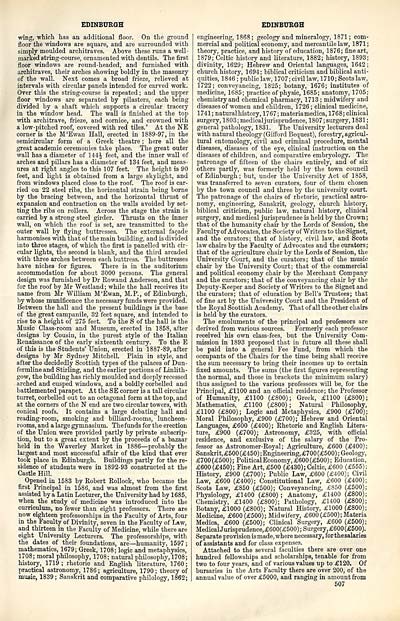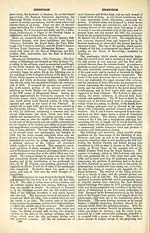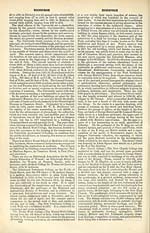Ordnance gazetteer of Scotland
(515) Page 507
Download files
Complete book:
Individual page:
Thumbnail gallery: Grid view | List view

EDINBURGH
wing, which has an additional floor. On the ground
floor the windows are square, and are surrounded with
simply moulded architraves. Above these runs a well-
marked string-course, ornamented with dentils. The first
floor windows are round-headed, and furnished with
architraves, their arches showing boldly in the masonry
of the wall. Next comes a broad frieze, relieved at
intervals with circular panels intended for carved work.
Over this the string-course is repeated ; and the upper
floor windows are separated by pilasters, each being
divided by a shaft which supports a circular tracery
in the window head. The wall is finished at the top
with architrave, frieze, and cornice, and crowned with
a low-pitched roof, covered with red tiles. ' At the NE
corner is the M'Ewan Hall, erected in 1889-97, in the
semicircular form of a Greek theatre ; here all the
great academic ceremonies take place. The great outer
wall has a diameter of 144J feet, and the inner wall of
arches and pillars has a diameter of 134 feet, and meas-
ures at right angles to this 107 feet. The height is 90
feet, and light is obtained from a large skylight, and
from windows placed close to the roof. The roof is car-
ried on 22 steel ribs, the horizontal strain being borne
by the bracing between, and the horizontal thrust of
expansion and contraction on the walls avoided by set-
ting the ribs on rollers. Across the stage the strain is
carried by a strong steel girder. Thrusts on the inner
wall, on which the roof is set, are transmitted to the
outer wall by flying buttresses. The external facade
harmonises with that of the main building, and is divided
into three stages, of which the first is panelled with cir-
cular lights, the second is blank, and the third arcaded
with three arches between each buttress. The buttresses
have niches for figures. There is in the auditorium
accommodation for about 3000 persons. The general
design was furnished by Dr Rowand Anderson, and that
for the roof by Mr Westland ; while the hall receives its
name from Mr William M'Ewan, M.P., of Edinburgh,
by whose munificence the necessary funds were provided.
Between the hall and the present buildings is the base
of the great campanile, 32 feet square, and intended to
rise to a height of 275 feet. To the S of the hall is the
Music Class-room and Museum, erected in 1858, after
designs by Cousin, in the purest style of the Italian
Renaissance of the early sixteenth century. To the E
of this is the Students' Union, erected in 1887-89, after
designs by Mr Sydney Mitchell. Plain in style, and
after the decidedly Scottish types of the palaces of Dun-
fermline and Stirling, and the earlier portions of Linlith-
gow, the building has richly moulded and deeply recessed
arched and cusped windows, and a boldly corbelled and
battlemented parapet. At the SE corner is a tall circular
turret, corbelled out to an octagonal form at the top, and
at the corners of the N end are two circular towers, with
conical roofs. It contains a large debating hall and
reading-room, smoking and billiard-rooms, luncheon-
rooms, and a large gymnasium. The funds for the erection
of the Union were provided partly by private subscrip-
tion, but to a great, extent by the proceeds of a bazaar
held in the Waverley Market in 1886 — probably the
largest and most successful affair of the kind that ever
took place in Edinburgh. Buildings partly for the re-
sidence of students were in 1892-93 constructed at the
Castle Hill.
Opened in 1583 by Robert Rollock, who became the
first Principal in 1586, and was almost from the first
assisted by a Latin Lecturer, the University had by 1685,
when the study of medicine was introduced into the
curriculum, no fewer than eight professors. There are
now eighteen professorships in the Faculty of Arts, four
in the Faculty of Divinity, seven in the Faculty of Law,
and thirteen in the Faculty of Medicine, while there are
eight University Lecturers. The professorships, with
the dates _ of their foundations, are — humanity, 1597;
mathematics, 1679; Greek, 1708; logic and metaphysics,
1708; moral philosophy, 1708; natural philosophy, 1708;
history, 1719 ; rhetoric and English literature, 1760 ;
practical astronomy, 1786; agriculture, 1790; theory of
music, 1839 ; Sanskrit and comparative philology, 1862;
EDINBURGH
engineering, 1868 ; geology and mineralogy, 1871 ; com-
mercial and political economy, and mercantile law, 1871;
theory, practice, and history of education, 1876; fine art,
1879; Celtic history and literature, 1882; history, 1893;
divinity, 1629; Hebrew and Oriental languages, 1642 ;
church history, 1694; biblical criticism and biblical anti-
quities, 1846 ; public law, 1707 ; civil law, 1710 ; Scots law,
1722; conveyancing, 1825; botany, 1676; institutes of
medicine, 1685; practice of physic, 1685; anatomy, 1705;
chemistry and chemical pharmacy, 1713 ; midwifery and
diseases of women and children, 1726; clinical medicine,
1741 ; naturalhistory, 1767 ; materia medica, 1768; clinical
surgery, 1803; medical jurisprudence, 1807; surgery, 1831 ;
general pathology, 1831. The University lecturers deal
with natural theology (Gifford Bequest), forestry, agricul-
tural entomology, civil and criminal procedure, mental
diseases, diseases of the eye, clinical instruction on the
diseases of children, and comparative embryology. The
patronage of fifteen of the chairs entirely, and of six
others partly, was formerly held by the town council
of Edinburgh; but, under the University Act of 1858,
was transferred to seven curators, four of them chosen
by the town council and three by the university court.
The patronage of the chairs of rhetoric, practical astro-
nomy, engineering, Sanskrit, geology, church history,
biblical criticism, public law, natural history, clinical
surgery, and medical jurisprudence is held by the Crown ;
that of the humanity chair by the Lords of Session, the
Faculty of Advocates, the Society of Writers to the Signet,
and the curators; that of history, civil law, and Scots
law chairs by the Faculty of Advocates and the curators;
that of the agriculture chair by the Lords of Session, the
University Court, and the curators; that of the music
chair by the University Court; that of the commercial
and political economy chair by the Merchant Company
and the curators; that of the conveyancing chair by the
Deputy-Keeper and Society of Writers to the Signet and
the curators; that of education by Bell's Trustees; that
of fine art by the University Court and the President of
the Royal Scottish Academy. That of all the other chairs
is held by the curators.
The emoluments of the principal and professors are
derived from various sources. Formerly each professor
received his own class-fees, but the University Com-
mission in 1893 proposed that in future all these shall
be paid into a general Fee Fund, from which the
occupants of the Chairs for the time being shall receive
the sum necessary to bring their incomes up to certain
fixed amounts. The sums (the first figures representing
the normal, and those in brackets the minimum salary)
thus assigned to the various professors will be, for the
Principal, £1100 and an official residence; the Professor
of Humanity, £1100 (£800); Greek, £1100 (£800);
Mathematics, £1100 (£800) ; Natural Philosophy,
£1100 (£800); Logic and Metaphysics, £900 (£700);
Moral Philosophy, £900 (£700); Hebrew and Oriental
Languages, £600 (£400); Rhetoric and English Litera-
ture, £900 (£700); Astronomy, £325, with official
residence, and exclusive of the salary of the Pro-
fessor as Astronomer-Royal; Agriculture, £600 (£400);
Sanskrit, £500 (£450) ; Engineering, £700 (£500) ; Geology,
£700(£500); Political Economy, £600 (£500); Education,
£600 (£450); Fine Art, £500 (£430); Celtic, £600 (£555);
History, £900 (£700); Public Law, £600 (£400); Civil
Law, £600 (£400); Constitutional Law, £600 (£400);
Scots Law, £850 (£500); Conveyancing, £850 (£500);
Physiology, £1400 (£800) ; Anatomy, £1400 (£800);
Chemistry, £1400 (£800); Pathology, £1400 (£800);
Botany, £1000 (£800); Natural History, £1000 (£800);
Medicine, £600 (£500); Midwifery, £600 (£500); Materia
Medica, £600 (£500); Clinical Surgery, £600 (£500);
Medical Jurisprudence, £600(£500); Surgery, £600 (£500).
Separate provision is made, where necessary, forthesalaries
of assistants and for class expenses.
Attached to the several faculties there are over one
hundred fellowships and scholarships, tenable for from
two to four years, and of various values up to £120. Of
bursaries in the Arts Faculty there are over 200, of the
annual value of over £5000, and ranging in amount from
507
wing, which has an additional floor. On the ground
floor the windows are square, and are surrounded with
simply moulded architraves. Above these runs a well-
marked string-course, ornamented with dentils. The first
floor windows are round-headed, and furnished with
architraves, their arches showing boldly in the masonry
of the wall. Next comes a broad frieze, relieved at
intervals with circular panels intended for carved work.
Over this the string-course is repeated ; and the upper
floor windows are separated by pilasters, each being
divided by a shaft which supports a circular tracery
in the window head. The wall is finished at the top
with architrave, frieze, and cornice, and crowned with
a low-pitched roof, covered with red tiles. ' At the NE
corner is the M'Ewan Hall, erected in 1889-97, in the
semicircular form of a Greek theatre ; here all the
great academic ceremonies take place. The great outer
wall has a diameter of 144J feet, and the inner wall of
arches and pillars has a diameter of 134 feet, and meas-
ures at right angles to this 107 feet. The height is 90
feet, and light is obtained from a large skylight, and
from windows placed close to the roof. The roof is car-
ried on 22 steel ribs, the horizontal strain being borne
by the bracing between, and the horizontal thrust of
expansion and contraction on the walls avoided by set-
ting the ribs on rollers. Across the stage the strain is
carried by a strong steel girder. Thrusts on the inner
wall, on which the roof is set, are transmitted to the
outer wall by flying buttresses. The external facade
harmonises with that of the main building, and is divided
into three stages, of which the first is panelled with cir-
cular lights, the second is blank, and the third arcaded
with three arches between each buttress. The buttresses
have niches for figures. There is in the auditorium
accommodation for about 3000 persons. The general
design was furnished by Dr Rowand Anderson, and that
for the roof by Mr Westland ; while the hall receives its
name from Mr William M'Ewan, M.P., of Edinburgh,
by whose munificence the necessary funds were provided.
Between the hall and the present buildings is the base
of the great campanile, 32 feet square, and intended to
rise to a height of 275 feet. To the S of the hall is the
Music Class-room and Museum, erected in 1858, after
designs by Cousin, in the purest style of the Italian
Renaissance of the early sixteenth century. To the E
of this is the Students' Union, erected in 1887-89, after
designs by Mr Sydney Mitchell. Plain in style, and
after the decidedly Scottish types of the palaces of Dun-
fermline and Stirling, and the earlier portions of Linlith-
gow, the building has richly moulded and deeply recessed
arched and cusped windows, and a boldly corbelled and
battlemented parapet. At the SE corner is a tall circular
turret, corbelled out to an octagonal form at the top, and
at the corners of the N end are two circular towers, with
conical roofs. It contains a large debating hall and
reading-room, smoking and billiard-rooms, luncheon-
rooms, and a large gymnasium. The funds for the erection
of the Union were provided partly by private subscrip-
tion, but to a great, extent by the proceeds of a bazaar
held in the Waverley Market in 1886 — probably the
largest and most successful affair of the kind that ever
took place in Edinburgh. Buildings partly for the re-
sidence of students were in 1892-93 constructed at the
Castle Hill.
Opened in 1583 by Robert Rollock, who became the
first Principal in 1586, and was almost from the first
assisted by a Latin Lecturer, the University had by 1685,
when the study of medicine was introduced into the
curriculum, no fewer than eight professors. There are
now eighteen professorships in the Faculty of Arts, four
in the Faculty of Divinity, seven in the Faculty of Law,
and thirteen in the Faculty of Medicine, while there are
eight University Lecturers. The professorships, with
the dates _ of their foundations, are — humanity, 1597;
mathematics, 1679; Greek, 1708; logic and metaphysics,
1708; moral philosophy, 1708; natural philosophy, 1708;
history, 1719 ; rhetoric and English literature, 1760 ;
practical astronomy, 1786; agriculture, 1790; theory of
music, 1839 ; Sanskrit and comparative philology, 1862;
EDINBURGH
engineering, 1868 ; geology and mineralogy, 1871 ; com-
mercial and political economy, and mercantile law, 1871;
theory, practice, and history of education, 1876; fine art,
1879; Celtic history and literature, 1882; history, 1893;
divinity, 1629; Hebrew and Oriental languages, 1642 ;
church history, 1694; biblical criticism and biblical anti-
quities, 1846 ; public law, 1707 ; civil law, 1710 ; Scots law,
1722; conveyancing, 1825; botany, 1676; institutes of
medicine, 1685; practice of physic, 1685; anatomy, 1705;
chemistry and chemical pharmacy, 1713 ; midwifery and
diseases of women and children, 1726; clinical medicine,
1741 ; naturalhistory, 1767 ; materia medica, 1768; clinical
surgery, 1803; medical jurisprudence, 1807; surgery, 1831 ;
general pathology, 1831. The University lecturers deal
with natural theology (Gifford Bequest), forestry, agricul-
tural entomology, civil and criminal procedure, mental
diseases, diseases of the eye, clinical instruction on the
diseases of children, and comparative embryology. The
patronage of fifteen of the chairs entirely, and of six
others partly, was formerly held by the town council
of Edinburgh; but, under the University Act of 1858,
was transferred to seven curators, four of them chosen
by the town council and three by the university court.
The patronage of the chairs of rhetoric, practical astro-
nomy, engineering, Sanskrit, geology, church history,
biblical criticism, public law, natural history, clinical
surgery, and medical jurisprudence is held by the Crown ;
that of the humanity chair by the Lords of Session, the
Faculty of Advocates, the Society of Writers to the Signet,
and the curators; that of history, civil law, and Scots
law chairs by the Faculty of Advocates and the curators;
that of the agriculture chair by the Lords of Session, the
University Court, and the curators; that of the music
chair by the University Court; that of the commercial
and political economy chair by the Merchant Company
and the curators; that of the conveyancing chair by the
Deputy-Keeper and Society of Writers to the Signet and
the curators; that of education by Bell's Trustees; that
of fine art by the University Court and the President of
the Royal Scottish Academy. That of all the other chairs
is held by the curators.
The emoluments of the principal and professors are
derived from various sources. Formerly each professor
received his own class-fees, but the University Com-
mission in 1893 proposed that in future all these shall
be paid into a general Fee Fund, from which the
occupants of the Chairs for the time being shall receive
the sum necessary to bring their incomes up to certain
fixed amounts. The sums (the first figures representing
the normal, and those in brackets the minimum salary)
thus assigned to the various professors will be, for the
Principal, £1100 and an official residence; the Professor
of Humanity, £1100 (£800); Greek, £1100 (£800);
Mathematics, £1100 (£800) ; Natural Philosophy,
£1100 (£800); Logic and Metaphysics, £900 (£700);
Moral Philosophy, £900 (£700); Hebrew and Oriental
Languages, £600 (£400); Rhetoric and English Litera-
ture, £900 (£700); Astronomy, £325, with official
residence, and exclusive of the salary of the Pro-
fessor as Astronomer-Royal; Agriculture, £600 (£400);
Sanskrit, £500 (£450) ; Engineering, £700 (£500) ; Geology,
£700(£500); Political Economy, £600 (£500); Education,
£600 (£450); Fine Art, £500 (£430); Celtic, £600 (£555);
History, £900 (£700); Public Law, £600 (£400); Civil
Law, £600 (£400); Constitutional Law, £600 (£400);
Scots Law, £850 (£500); Conveyancing, £850 (£500);
Physiology, £1400 (£800) ; Anatomy, £1400 (£800);
Chemistry, £1400 (£800); Pathology, £1400 (£800);
Botany, £1000 (£800); Natural History, £1000 (£800);
Medicine, £600 (£500); Midwifery, £600 (£500); Materia
Medica, £600 (£500); Clinical Surgery, £600 (£500);
Medical Jurisprudence, £600(£500); Surgery, £600 (£500).
Separate provision is made, where necessary, forthesalaries
of assistants and for class expenses.
Attached to the several faculties there are over one
hundred fellowships and scholarships, tenable for from
two to four years, and of various values up to £120. Of
bursaries in the Arts Faculty there are over 200, of the
annual value of over £5000, and ranging in amount from
507
Set display mode to: Large image | Transcription
Images and transcriptions on this page, including medium image downloads, may be used under the Creative Commons Attribution 4.0 International Licence unless otherwise stated. ![]()
| Gazetteers of Scotland, 1803-1901 > Ordnance gazetteer of Scotland > (515) Page 507 |
|---|
| Permanent URL | https://digital.nls.uk/97399426 |
|---|

